#Trading Patterns
Explore tagged Tumblr posts
Text
Importance of chart analysis for equity investments
Image by freepik Chart analysis, or technical analysis, can be quite helpful for equity investment in the Indian stock market. Here are several reasons why it is beneficial: Benefits of Chart Analysis in the Indian Stock Market 1.Trend Identification The Indian stock market, like any other, exhibits trends over time. Chart analysis helps in identifying these trends, allowing investors to ride…
#chart analysis#equity investment#Financial Markets#Indian stock market#investment strategies#market analysis#Market Sentiment#Stock Charts#Stock Market#Stock Trading#Support and Resistance#Technical Analysis#Technical Indicators#Trading Patterns#Trend Identification#Volume Analysis
3 notes
·
View notes
Text
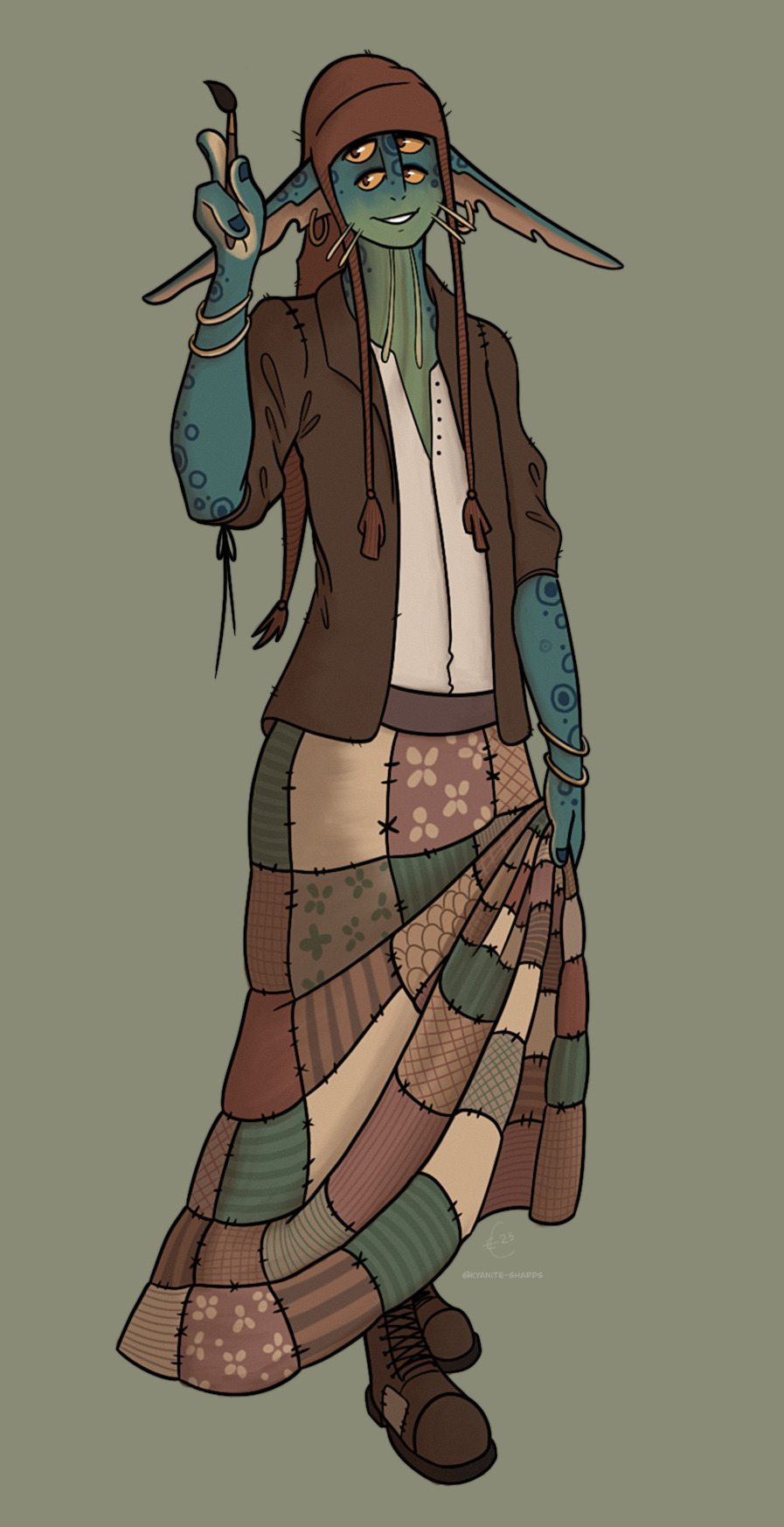
Part 2 of an Art Trade for @tadporridge of their beautiful version of Gabbro! ::3
#outer wilds gabbro#my art#pose from the pose archives#outer wilds oc art trade#took some artistic liberty on their scale pattern and skirt patterns#this Gabbro is just so earthy#I love it#dem whiskers!!!#gender envy honestly
154 notes
·
View notes
Text
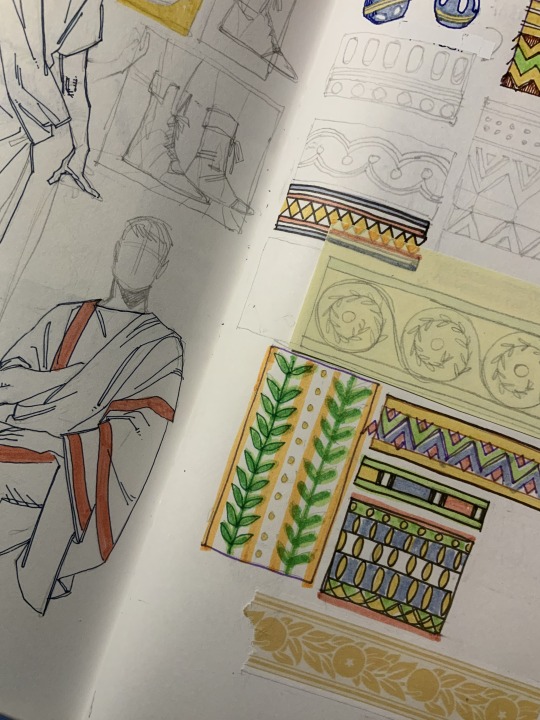

help carthage and coins featuring 4th century CE roman emperors have taken hold of my brain and won’t let go
#shoutout to trade based empires and their trading partners bc it’s doing a lot of heavy lifting for all these textile patterns etc#I can’t recreate Carthage but I sure can create positive space around the negative space where Rome fucking destroyed it
410 notes
·
View notes
Text
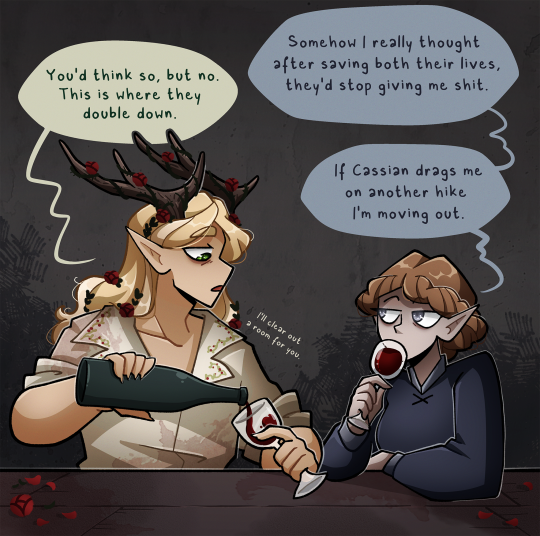
So that hofas bonus Ember chapter huh.
I wish Tamlin and Nesta built a casual friendship.
It's such a missed opportunity! They were both assigned penance eternal by the IC over their relationships with Feyre with no road to redemption. In acosf they were both on a shame spiral. You'd think this would be a like calls to like moment! Opportunity to recognise that just coz Rhys's friends hate you doesn't make you a bad person!
#my art#acotar#acotar fanart#tamlin#nesta archeron#neslin#hofas spoilers#but like very mild#Instead Nesta gets a 'growth moment' of joining the Tamlin hate train and I can't have nice things. >_>#and while i'm on the tamlin and nesta meeting#what was that retcon of tamlin asking nesta if she'd take feyre's place when he first came to grab her??#that wouldn't break the curse at all why would he trade??#anyway cassian is the worst mate and nesta should move out#how is him being the most angry at her for doing the right thing a pattern now??#how is them threatening to kill her a recurring thing??#someone save her from the night court i am begging
754 notes
·
View notes
Note
What’s the architecture/layout of old Bur, how do modern people perceive the ruins?
The city in its peak was very large and spread over both shoreline and a network of small islands. These islands comprised a waterfront district connected by a network of bridges and canals, where a large portion of its non-agricultural lower class lived.
It had a fairly well organized and efficient freshwater+sanitation system across most of its span (the canal district had less effective plumbing largely due to logistical difficulties, most of its wastewater was instead flushed by rain powered cisterns). The water system was powered by the Hsuke river and made fresh water readily accessible throughout the majority of the city (though few homes had direct freshwater plumbing). It had several major public baths, and the homes of the wealthiest members of society had their own private bathing pools.
In this part of the world, it is broadly regarded as once being one of the most beautiful cities to have ever existed. It was particularly noted for its water gardens (still a fixture of present day Burri culture) which were absolute marvels of engineering for that period, with the majority of these being entirely artificial and supported by its network of aqueducts. These hosted thousands of ornamental plants, fish, and fowl, as well as fruiting trees and shrubs. They were treated as a public work meant to benefit all citizens, and existed throughout the city.
The palace in particular was noted as impressive, in part for its architecture but mainly for its gardens. These hosted 'exotic' plants and a menagerie of animals from across the empire's territory, and existed in part as a symbol of the state's power and reach. It was a trend for emperors to bring in the fiercest animal from each conquered province to the grounds, with the an-nechoi being the beast of choice from the lands across the sea to the east, with one (Probably erroneously) cited as killing thirty servants in the process of moving it into the gardens.
The palace was located within the temple district. This district housed over a hundred shrines to the various lesser deities of the pantheon, and temple complexes to the seven chief deities (the firstborn gods who created the world, all other gods were later descendants). Old Burri temples were Kinda similar in shape to a ziggurat, though had an accessible interior space and a central tower which housed the shrine. At this time, the chief gods were believed to physically inhabit their temples. Each god had its own high priest permitted to attend to their shrine, with the emperor being the high priest to Inanariya (king of the gods) and the only person permitted to directly commune with this deity. The foundations to these temples are relatively intact in the present day, though none of the towers remain (collapsed in earthquakes with no one to rebuild them).
The city was heavily fortified, having one external wall surrounding most of its length, and an internal wall surrounding the palace/temple district (which doubled as a fortress).
---
The period of sea level rise began with a 500ish year period of mostly gradual increase, which occurred slowly enough that most infrastructure could adapt very easily and the problem went unnoticed by most (the city of Bur experienced most of its Growth during this time). It then culminated with about a century of (relatively) rapid rise, which is the direct cause of the city's abandonment.
The canals flooding had always been a problem during storms, but this began to occur with notable frequency, alongside the water level as a whole rising quickly enough to be noticed on an immediate human timespan. The canal district was maintained for a while by rerouting some of its waterways and building up barriers, but it was the first part of the city to be abandoned. Things got more serious when the mainland parts of the city grew increasingly impacted by storm surges that never seemed to fully retract, and major parts of its surrounding farmland were hit by surges and tidal waves, and rendered too saline to remain arable.
The actual single biggest cataclysm was the collapse of the city's mainland sewage system. It was built with flood canals as a failsafe, but these were built to withstand heavy rain rather than an encroaching ocean. Storm surges would cause large segments of the city to be flooded with sewage (including some of the freshwater plumbing), and serious disease outbreaks would follow.
These issues were enabled/exacerbated by earthquakes (the region is geologically active and this isn't unusual) that further damaged and mingled the sewage and freshwater systems. One earthquake and its subsequent tidal wave was a turning point, and the resulting breakdown of (already strained) infrastructure rendered a large swath of the city uninhabitable in the space of about a week. This also just caused immediate damage to much of the city's architecture/walls, and collapsed the tower of the temple to Inanariya (never a good sign). This is when the full exodus began, first with people flocking to un-flooded parts of its city and farmlands, and those who could afford it fully relocating to other cities/towns.
All of this issues were compounded by the 1st Burri Empire already being in a period of collapse at this time. This was largely a matter of simple overextension. Its borders were constantly under attack by rival states/its victims, sometimes with great success. Bur's own population had burgeoned well past what the imperial core land could sustain, and its cities relied predominantly on extraction of foreign grain/goods to feed their people. It lost most of its eastern land holdings in a fairly rapid timespan (overextended with wars at multiple fronts), which caused frequent famines in its core.
This put pressure on its final emperors to invest in increasingly desperate expansionist projects, while attempting to keep up public morale with lavish public works and objectively stupid vanity projects. The attempt to excavate a canal at the Viper seaway's 'tail' (one of the few eastern regions it retained secure control of at that point) was in part a desperate act to revive its economy by opening up/monopolizing a new trade system. The amount of money and manpower sunk into this ultimately doomed project was followed by Bur being fully ousted from its eastern holdings, and was one of the final straws in its collapse.
People in the city of Bur proper were dealing with the double front of starvation and their homes + streets + immediate water supply being flooded with seawater and literal human feces. These issues impacted the lower classes first and most severely, but ultimately transcended class boundaries. Famine grew more and more rampant, not only with the loss of the colonial holdings that supported the population but of farmland in the imperial core- much of the city of Bur's immediate farmlands were unproductive due to repeat inundation with saltwater during surges, and the farmland along the Yamage river to the north was rapidly being captured and pillaged by the Hsem (historical enemies, a nomadic group with a khait warrior culture from further west).
All this was fucking unlivable in of itself, but also had very obvious implications in the context of Burri emperors also being high priests and the chief intermediary between the gods and the people. Not only was the government failing to sustain its citizens to begin with, but signs of divine disapproval were deeply apparent.
So the last days of the 1st Burri empire were a chaotic period of civil unrest, most acute in and around city of Bur proper. This involved near-constant peasant revolts and several attempted coups. The last Burri emperor (of the First empire) ultimately fled the capital of Bur and reestablished in Titenegal, declaring it the new capital. This was then sacked by the Hsem within a year and after that it was fucking Joever.
The city of Bur was functionally abandoned by this point. People still Lived There and there were several attempts to set up a new government, all of which failed in the short term. After the collapse was complete, its inhabitants were mostly just peasants who built up new homes further inland and sustained themselves on the remaining farmland. Few people lived permanently in the city proper due to all of its intact infrastructure being effectively non-functional without the governmental bodies/human labor to sustain it.
---
It should also be noted that it was Extremely not just Bur that was flooded, the sea level rise was worldwide (resulting from a collapsing ice sheet) and almost Every coastal city during this period experienced the same issue. Bur's demise was just notably dramatic in that it was once the most heavily populated human city that has Ever Existed, and directly correlated with the fall of the empire it hosted.
The flooding was fairly gradual, but it's been 7 centuries since the first Burri empire's collapse and the fall of its capital city, and many contemporary records were lost to the immediate chaos and to the large span of time since. Cultural memory tends to reframe the flood VERY rapid on a human scale, many of the stories describe the city being swallowed in a single wave as an act of divine punishment (the popular notion at the time that the last emperors deeply displeased and shamed the gods has stuck into the narrative, often exaggerated into stories of them being horrifically debauched blasphemers guilty of the worst disgraces imaginable). Even more conservative accounts tend to imagine the totality of the destruction taking place over the span of about a year (merging the memories of the immediate earthquake devastation with more gradual elements of its slow flooding). People widely believe that most of its residents drowned in the city's cataclysmic demise, and that the ruins are now Extremely haunted.
The state of the flooding is not 'completely under the sea' and you can still walk/wade through most of the inland ruins (the canal district is effectively submerged, with most structures that Would be above the water level having collapsed against the strain). As such, some people Do Live Here. These people are mostly smugglers and pirates using the ruins as a hideout, and/or opportunistic hunters and fishermen who won't let ghosts stop them. Entering the city ruins is currently forbidden (largely Because of the criminal nature of basically every motive to go here (even hunting, which is considered poaching)), but enforcement of this rule/active patrols to prevent entry are inconsistent.
The majority of Old Bur's inhabitants are animals. The un-flooded parts of the city and its gardens are now a host to a thriving community of native plants and animals (and a few descendants of escaped non-native zoo animals/ornamental plants that adapted well to the conditions).
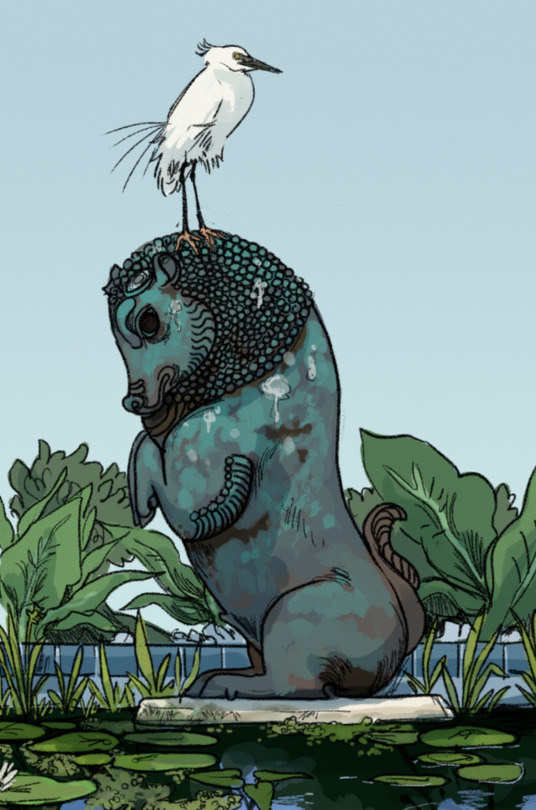
The egret shown here is a foreign species originally brought as an ornamental bird. In the centuries since its first import, it has become widespread and occurs on both sides of the Mouth seaway. It can hunt in both freshwater and saline environments, and a very large population lives permanently in the ruins of Old Bur.
Its common name is the ghost egret. Contemporary Burri folklore holds that the ghost egrets of Old Bur are literal ghosts, carrying the souls of those who died in the cataclysmic floods.
#[[JUST REALIZED you didn't even fucking. ask about the timeline of the flooding I just kinda went for it]]#[[its relevant to its contemporary state I guess????]]]#Added the photo without linking to the original post becasue it is WILDLY outdated.#Among other things I cited the population of the original city of Bur at 'over a million people'. Which is contextually ridiculous#Also (because this probably gets confusing) everything here describes the first of two empires out of Bur which was by far#the larger one. The second had a similar pattern in its downfall (overextension - famines at home - war and revolts at multiple fronts)#but was significantly less dramatic and had a much cleaner rebound (it ended in a successful coup that the contemporary#Burri Republic directly descends from)#I used to describe 3 Burri empires which. I don't know why I did that because the 1st of the three was an ANCIENT land empire#stemming from further west where contemporary Bur was its easternmost extent of Conquered lands. This collapsed like ~1500+#years before present and has no directly obvious impact on modern conditions whatsoever (it DID have major impacts#though: it's what first brought khait to this region and some of its ancient roads are still used in the largest continuous land#trade network in the northern hemisphere)
104 notes
·
View notes
Text

Team Haiti's opening ceremony uniforms for the 2024 Olympics, designed by Haitian-Italian designer Stella Jean.

The trousers and skirts are printed with 'Passage', an artwork by Haitian artist Philipe Dodard.
'...Stella Jean says she created uniforms on a humble budget for Team Haiti, one of the smallest delegations in the Olympics with just seven athletes...
...The look takes its white, red, and blue hues from the Haitian flag, with the men’s uniform consisting of a light blue jacket, an adaptation of the guayabera shirt worn by men in the Caribbean, vibrant trousers channeling Naïve folk art, and a Fular scarf. The women’s look features a skirt in the same material, paired with a light blue shirt and structured jacket with a cinched waist. Philippe Dodard, an acclaimed Haitian painter, designed the fabric for the trousers and skirt.
Wearing these uniforms at the Paris Olympics takes on an even deeper meaning for Haiti, once known as Saint-Domingue, a French colony that fought for its independence during the Haitian Revolution, the first successful resistance movement led by enslaved people against the French colonial regime from 1971 to 1804. “It’s hugely symbolic,” says Jean, who is Haitian-Italian, adding that she merged Haitian fabrics and motifs with Western silhouettes as “a tool of counter colonization.”
Jean ran into some issues as she worked to create her designs. Export embargoes in Haiti made sourcing chambray, a cotton-like material, for the women’s shirt difficult. “I used one of my dresses that my grandmother gave to me, because we were not able to source it otherwise. I hope she will forgive me because she's not here anymore,” Jean says, joking that her design unintentionally became more sustainable.
Throughout the process, she recognized the rare opportunity to present the world with a positive news story about Haiti, as the country struggles with a recent history of political violence, coups, and the deadly 2020 earthquake. Ongoing violence at the hands of armed gangs has displaced approximately 580,000 people, per U.N. figures.
“Haiti has no materials now. We have nothing to sell to the world. Our strength right now is this intangible richness [from] our deep culture,” Jean says. “We are here, we are joyful, and we will be back on our own two feet again.”...' Time Magazine
#stella jean#team haiti#paris olympics#olympics opening ceremony#haiti#haitian#uniforms#philipe dodard#pattern#surface pattern#surface pattern design#pattern design#textile design#textiles#fashion#print#printed textiles#time magazine#colonial history#colonization#french colonialism#colonialism#trade embargo#chambray
142 notes
·
View notes
Text
Weird thought that I honestly might actually crochet every single Pokemon before I find a job 😬
#text#new trade idea. get me a good job and i will give you your favorite 6 pokemon 😫#isn't it crazy that it's much easier to crochet 1025 pokemon with no patterns than it is to obtain a decently paying job!!!#that's messed up!!!#in such a weird headspace right now#blogger lore
100 notes
·
View notes
Text
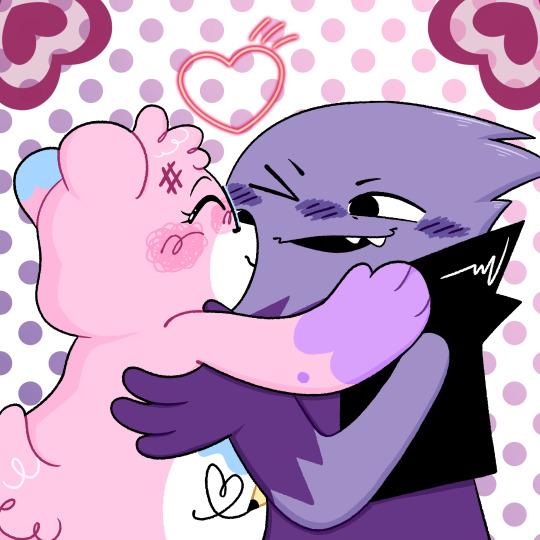
Art Trade piece for @milkofjeg !
#art trade#care bears unlock the magic#others ocs#I was experimenting with pattern brushes on fire alpaca
34 notes
·
View notes
Text

Did an art trade with @mythosaursarecool
Here's my half! It's their mytho oc zooming after a speeder who's probably about to have a heart attack lol
This was so fun to draw I love this design so much and just how big these guys are!!
#my art#art trade#mythosaur#mythosaur oc#now is the person about to get eaten or just the scare of their life#also the pattern on these guys is so cool!!!!!!#dhkadb i accidentally saved this drafts and didnt notice for like 10 minutes lmaooo#i was like....where the fuck is the post???
48 notes
·
View notes
Text










Prehistoric Pottery Selection 1, Wiltshire Museum, Devizes
#ice age#stone age#bronze age#iron age#prehistoric#prehistory#neolithic#mesolithic#paleolithic#archaeology#pottery#prehistoric pottery#urn#beaker#patterns#ancient living#ancient craft#ancient trade#ancient cultures#Wiltshire#pottery fragments
85 notes
·
View notes
Text
Art Trade Octosona
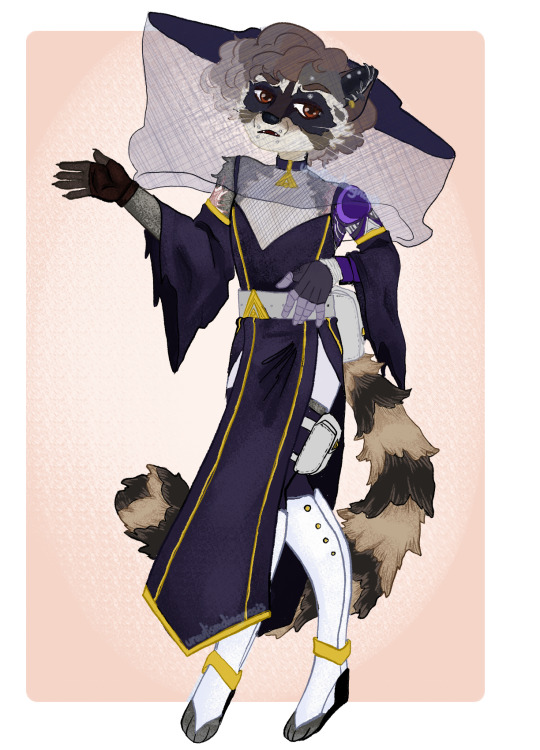
@traumatizedartist
Here they are 💅✨ i hope u like the artistic liberties I took lol
Ik the pose could def use some improvement on the perspective but I tried 😭🙏 hope i did ur octosona justice! ^v^
#octonauts#my art#Not my character#Not part of my octonauts au#Octosona#Art trade uwu#octonauts art#I didnt wanna make the like mesh too dark because it'd hide the face and fur patterns alot#But eh#Hope u enjoy lol
20 notes
·
View notes
Text
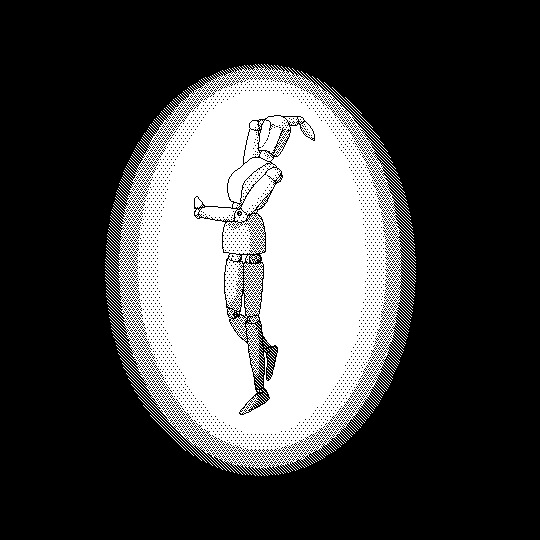
does the function justify the performance?
#book's pixels#jack of all trades master of none#pixel art#i did this one in a totally different way essentially shading how i'd normally do for something very minimal#and then filling it in with a dither pattern i made beforehand#i think this gives a less smooth look but it was certainly faster#i think this one might be bigger than i want to work with tho#it's 540x540 and i usually work with canvases in the 250-350 range
26 notes
·
View notes
Text
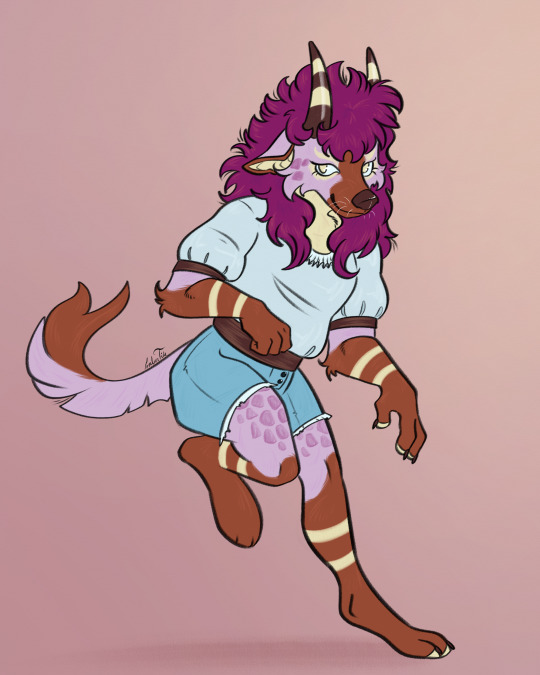
my half of an art trade i did with @sacr3lege of a very cool yeen! this was lots of fun and i hope i did her justice hehehe
#art#sombertide art#digital art#oc#furry#hyena#fursona#art trade#not my oc#not my character#i'm so used to doing very simple characters#the patterns and colors were a bit tricky but i think i did well lol#it was so fun
16 notes
·
View notes
Text

🌺: art trade from medibang :)
#art#my art#artists on tumblr#digital art#fanart#art trade#mouthwashing#<- thing that freaks me out Yippee !! kfhshfvhd#i really like how the patterning on the shirt turned out ?? so :D !!#his goofy hat is pretty good i like that :3#i should do more patterning by hand though gouuu#yea tho. that is all#[sinks into the bog slowly. maintaining eye contact]
21 notes
·
View notes
Text
"Hotd costume design was fine, you can't still be angry."
This is how they had Laena and Her daughters dressed in ESSOS?!

It's not the worst thing in the world, and thankfully, face cards carry house Velartarg, but the language of Essos isn't communicated. You can make the arguement that Laena wants them to feel like Westeros girls but that doesn't make sense because Daemon says their home is in Pentos sho to communicate that, them looking Pentoshi or calling back to Daenerys fashion in Essos would make the most sense for this disconnect and establish Essos at this point in history.
Rip Dany and Missandei. Mothers didn't live and die by the cloth to be represented in this light.


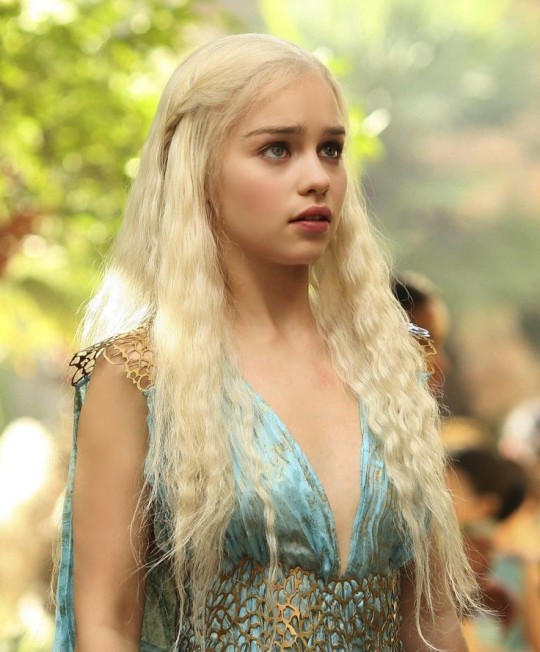
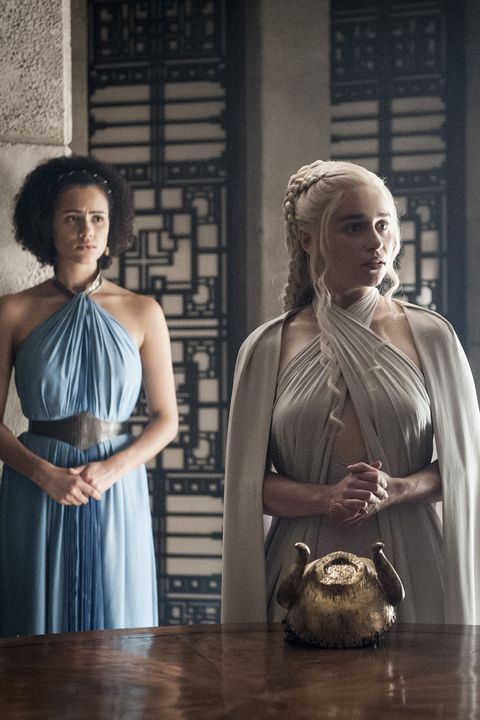




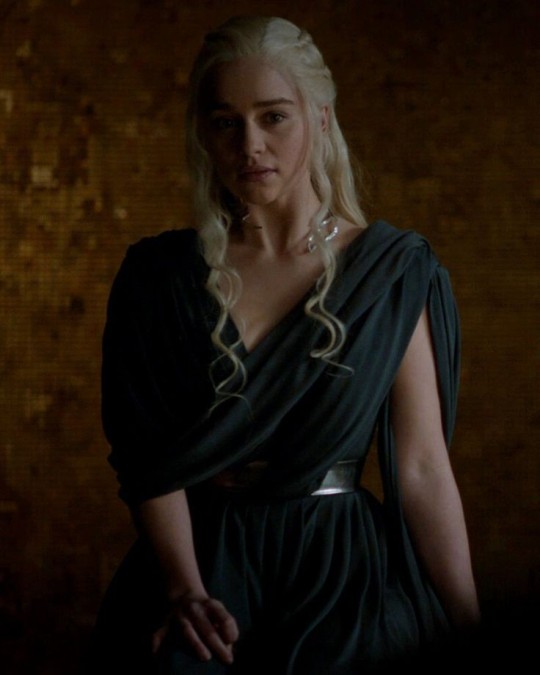
#hotd#house of the dragon#hotd costumes#hotd critical#yes they are kids and pregnant but#the language of essos is lost in the fits#dany an Missandei are a good example of this#especially with the transition to westeros in season 7#at least play with the language of the world#why were they in so much white#why were their no dragon scale patterns to be seen on Laena casually#essos#essos fashion#also#house Velaryon trades with essos all the time#dont piss me off
61 notes
·
View notes
Note
please please please what pattern did you use for this beautiful thing? i'm fighting for my life trying to find a cat pattern like this so if you have a pattern/if you freehanded it and have any tips or insight that would be greatly appreciated. thank you ^_^

This pattern isn't mine, and it is free! I'll link to the post I made that has both the pattern I used and the notes for how I modified it (because I do not remember lol)
#ask away!#I love this cat pattern! That cat was for an art trade#for a little painting of a frog fortune teller#the first cat (the one in the link) is named Binx! :D
23 notes
·
View notes